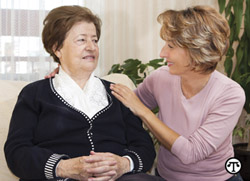
(NAPSI)—If you’re among the more than 65 million Americans who care for a loved one living with a chronic illness, you have a unique understanding of this critical role. The value of caregiving is particularly evident for the more than 15,600 people who are estimated to be diagnosed with chronic lymphocytic leukemia (CLL) each year, as persons diagnosed with CLL are typically elderly and often require care for an extended period of time.
“Caregivers such as me play an active role in the management of our loved one’s disease, especially in the case of a chronic blood cancer like CLL,” said Karenann Pantozzi of Hasbrouck Heights, New Jersey. “Some patients, like my partner Bob, may experience symptoms from their illness and side effects from treatment, so I found it to be important to provide the supportive care at home that he needs to help manage any problems.” Caregivers may be able to help their loved one remain in their own home and community while still providing the quality care and support they require. This may include driving to appointments, ensuring compliance to medications and preparing meals.
Jayshree Shah, Nurse Practitioner, Hackensack University Hospital, says, “To best manage chronic illness care, it’s important for patients to have a full team of health care providers and supportive caregivers to understand and discuss all treatment options.”
To be able to help their loved one, caregivers of CLL patients should strike a balance between time for themselves and maintaining an active role. Nearly three-quarters of family caregivers report not going to the doctor as often as they should, 63 percent have poor eating habits and 58 percent have worse exercise habits than before taking on their role as caregivers.
As a caregiver, you should:
- Take charge of your life, and don’t let your loved one’s illness take center stage. You’re doing a very hard job and deserve time just for yourself.
- Encourage your loved one to talk to you about his or her emotions. Patients with CLL may experience depression or anxiety, so it’s important to maintain an open dialogue.
- Join a CLL or blood cancer support group with your loved one to hear other people’s stories, gain valuable insights and learn coping strategies.
- Be open to the various online resources that are available for those living with CLL, including resources offering helpful tips on managing finances and navigating insurance during this difficult time.
- Educate yourself about CLL. Knowledge is power.
CLL is one of four main types of leukemia. It occurs when white blood cells, or lymphocytes, in bone marrow multiply, replace normal lymphocytes in the marrow and lymph nodes, and leave less room for healthy blood cells as well as platelets, resulting in infection, anemia and bleeding. Symptoms can include:
- Swollen lymph nodes
- Pain
- Fullness below the ribs
- Recurring infections
- Tiring easily
- Unintended weight loss
- Shortness of breath during light activity.
These symptoms develop slowly and are more likely to occur in older people. CLL is usually found during a routine blood test as part of a regular physical exam. Treatments may include medication, surgery, radiation, and chemotherapy. TREANDA® (bendamustine HCl) for Injection is a chemotherapy approved by the U.S. FDA for the treatment of patients with CLL. However, efficacy relative to first-line therapies other than chlorambucil has not been established. As with many medications, patients may experience side effects and require a change in therapy as a result, so it’s important for caregivers to be present during doctor visits.
For more information about CLL treatments, ask your doctor or visit www.TREANDA.com.
Indication
TREANDA is indicated for the treatment of patients with chronic lymphocytic leukemia (CLL). Efficacy relative to first-line therapies other than chlorambucil has not been established.
Important Safety Information
• Serious side effects, including low blood cell counts, infections, unexpected responses to TREANDA when placed in your blood, sudden and severe allergic responses, kidney failure due to fast breakdown of cancer cells, other cancers, and leaking of TREANDA out of your vein and into your surrounding skin, have been seen with TREANDA. Some responses, such as low blood counts, infections, and severe allergic skin responses (when TREANDA was given with allopurinol and other medications known to cause severe allergic skin responses), have caused death. Patients should be watched closely for these responses and treated quickly if any are seen.
• Serious side effects may require changes in therapy, such as lowering the amount of TREANDA given, stopping the use of TREANDA, or waiting longer than expected between doses of TREANDA.
• TREANDA should not be used in patients with a known allergic response to bendamustine or mannitol (an inactive ingredient in TREANDA). Women should be told not to become pregnant while using TREANDA.
• The most common non-blood-related side effects associated with TREANDA (occurring in ≥15 percent of patients) are fever, nausea, and vomiting. The most common blood-related side effects associated with TREANDA (frequency ≥15 percent) are low red blood cells (oxygen carrying cells), low platelets (blood-clotting cells), and decreased number of three different types of white blood cells (infection-fighting cells).
Full prescribing information is available at http://www.TREANDA.com/pdf/TREANDA_final_PI.pdf. This information is provided by Teva.